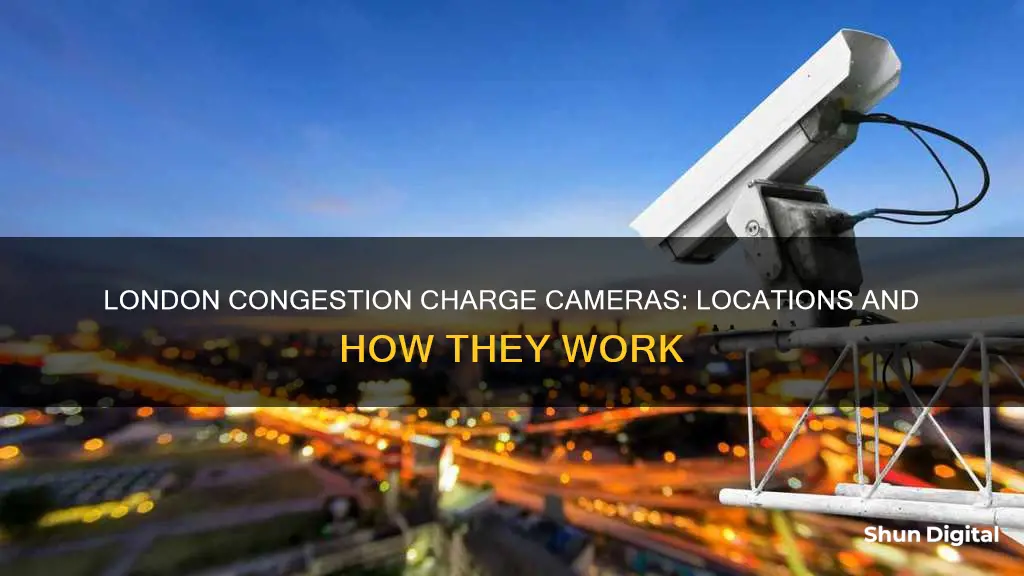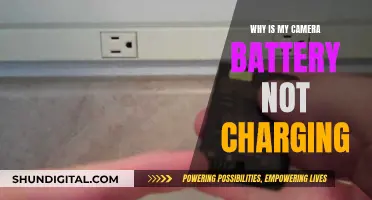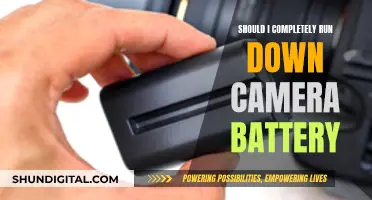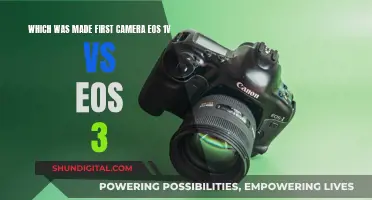
The Congestion Charge is a road toll that applies across London's City and West End to reduce traffic and pollution, improve health, and boost the economy by encouraging the use of public transportation. The charge is enforced by a network of cameras situated at entry and exit points to the charging zone and at key locations within the zone itself. These cameras are equipped with Automatic Number Plate Recognition (ANPR) technology, which captures images of vehicles entering and exiting the Congestion Charge Zone. The images are then processed to identify the vehicle's registration plate and check if the Congestion Charge has been paid. The Congestion Charge can be paid online, by phone, text message, post, or through the TfL Pay to Drive app.
| Characteristics | Values |
|---|---|
| Number of Congestion Charge Cameras | 197 |
| Camera Type | Fixed |
| Camera Technology | Automatic Number Plate Recognition (ANPR) |
| Camera Models | Siemens and PIPS Technology cameras |
| Camera Sensors | Charged Couple Device (CCD) and X-wave technology |
| Camera Positions | 400 positions throughout the congestion charging zone, with 180 on the inner ring road |
| Camera Mounts | Up to seven cameras mounted at each position on eight-metre poles |
| Camera Maintenance | Initial Electronic Security Systems (IESS) |
| Camera Relocation | Possible, as and when required |
| Camera Images | Sent to a central processor for verification |
| Camera Image Storage | Permanent Evidence Store repository (PES) and Worm drive (Write Once Read Many) |
| Camera Image Encryption | Encrypted and digitally signed at the first point of capture |
| Camera Image Deletion | Deleted upon payment of Congestion Charge |
What You'll Learn
- Congestion charge cameras use automatic number plate recognition (ANPR) technology
- There are 197 congestion charge cameras monitoring entry and exit points
- TfL holds the locations of congestion charge cameras
- Congestion charge cameras are fixed and not mobile
- Congestion charge camera images are called 'Evidential Records'

Congestion charge cameras use automatic number plate recognition (ANPR) technology
ANPR cameras are typically equipped with high-resolution sensors, infrared illuminators, and wide dynamic range capabilities to capture clear and accurate images of license plates, even in low-light or nighttime conditions. The technology can automatically extract alphanumeric characters from the license plate image and convert them into text, enabling the identification of vehicles.
In London, there are currently 1,500 cameras that use ANPR technology to enforce the Congestion Charge Zone. These cameras are placed at every entrance and exit of the zone, with additional cameras placed at strategic points throughout the zone to ensure compliance. The video streams from these cameras are transmitted to a data centre, where the ANPR software processes the images and identifies vehicles that have not paid the charge.
The use of ANPR technology in London's Congestion Charge Zone has been controversial due to privacy concerns and the potential for mass surveillance. However, supporters argue that it is an effective way to reduce traffic congestion and improve the flow of people and vehicles in the city.
Overall, ANPR technology plays a crucial role in enforcing the Congestion Charge Zone in London, providing an automated and efficient system for monitoring and charging vehicles entering the zone.
Are Camera Batteries Charged? Understanding Camera Battery Basics
You may want to see also

There are 197 congestion charge cameras monitoring entry and exit points
In London, there are 197 congestion charge cameras monitoring entry and exit points to the Congestion Charge Zone. These cameras are equipped with Automatic Number Plate Recognition (ANPR) technology, which takes photos of vehicles entering the zone and captures their registration plates. The images are then sent to a central processor, where the registration plates are read and checked against a database of vehicles that have paid the Congestion Charge. This system ensures that vehicles entering the zone are properly charged and helps to enforce the Congestion Charge scheme.
The Congestion Charge Zone covers most parts of Central London, including Westminster and the City of London, and is generally bordered by the Inner Ring Road. This zone was introduced to reduce traffic congestion and encourage the use of public transportation. The charge applies from 7 am to 10 pm, Monday to Friday, and there are clear signs indicating the entry points to the zone.
The Congestion Charge scheme has been controversial since its introduction in 2003 by then-Mayor of London, Ken Livingstone. Despite this, the scheme has been successful in reducing traffic. Each day in 2006, there were around 70,000 fewer vehicles entering the charging zone compared to before the scheme was implemented. This represents a 20% reduction in traffic, which has also had a positive impact on cycling, with a significant increase in the number of cyclists on London's roads.
The revenue generated from the Congestion Charge, estimated at around £130-150 million per year, is used to improve public transportation in London. This includes enhancing bus services and making other improvements to encourage people to leave their cars at home and take public transportation instead. In addition to the fixed cameras at entry and exit points, there are also mobile camera vans deployed at undisclosed locations within the Congestion Charge Zone to further enforce the scheme.
Charging Waterproof Camera Batteries: Pentax Edition
You may want to see also

TfL holds the locations of congestion charge cameras
Congestion charge cameras are placed at every entrance and exit of the Congestion Charge zone in London. There is a black and white camera for each lane of traffic to capture registration plates, and a colour camera to record an overview of the whole road. There are also further cameras placed at strategic points throughout the zone to reduce the chances that vehicles will enter and go unnoticed.
The cameras are equipped with Automatic Number Plate Recognition (ANPR) technology, which takes pictures of vehicles' number plates to identify registered users for charging. The images are then sent to a central processor, where number plates are read and checked against a list of vehicles that have paid the Congestion Charge. TfL quotes a 90% success rate for accurately capturing each and every number plate, a figure that rises as the vehicle passes more camera positions.
The Congestion Charge zone covers Central London, including most parts of Westminster and the City of London. It is bordered by the Inner Ring Road, which forms its boundary and provides a way for through traffic to avoid the zone. The zone is marked by road signs and markings featuring a red disc containing a white "C".
There are 197 Congestion Charge cameras monitoring the exit and entrance of the streets. TfL has also stated that it does not have mobile cameras such as vehicle-mounted systems, but it does have cameras that can be relocated as and when required.
Charging Drift HD Camera Batteries: A Step-by-Step Guide
You may want to see also

Congestion charge cameras are fixed and not mobile
Congestion charge cameras in London are fixed and not mobile. They are placed at every entrance and exit from the Congestion Charge zone, with a black and white camera for each lane of traffic to capture registration plates, and a colour camera recording an overview of the whole road.
There are 197 Congestion Charge cameras monitoring the exit and entrance of the streets. All pictures taken by the cameras are called 'Evidential Records' (ER) to document those who will be required to pay the Congestion Charge. With the camera's Automatic Number Plate Recognition (ANPR) design, the plate number of the vehicle is included in the picture to identify which registered user is charged.
The Congestion Charge zone covers Central London, including most parts of Westminster and the City of London. It is bordered by the Inner Ring Road, which forms its boundary and provides a way for through traffic to avoid the zone. The zone is marked by road signs and markings featuring a red disc containing a white "C". The roads forming the zone boundary are free to use.
The Congestion Charge scheme was introduced in 2003 to reduce traffic in Central London and encourage the use of public transport. The scheme has been successful in reducing traffic, with around 70,000 fewer vehicles entering the charging zone each day compared to pre-2003 levels. The revenue generated by the Congestion Charge, approximately £130-150 million per year, is used to improve public transport in London.
Charging Nixon Camera Batteries: A Step-by-Step Guide
You may want to see also

Congestion charge camera images are called 'Evidential Records'
Congestion charge cameras in London are placed at every entrance and exit of the Congestion Charge zone. There is a black and white camera for each lane of traffic to capture registration plates, and a colour camera recording an overview of the whole road. These cameras are called Automatic Number Plate Recognition (ANPR) cameras.
The images captured by these cameras are called Evidential Records. Evidential Records are used to identify vehicles that have not paid the Congestion Charge. The black-and-white image of the vehicle showing its registration number is stored for prosecution and possible court cases. The image from the colour camera is also stored to provide corroborative evidence, such as the colour and make of the vehicle, to prove the vehicle was correctly identified.
Transport for London (TfL) uses ANPR cameras to monitor vehicles entering and exiting the Congestion Charge zone. The camera captures the vehicle's registration plate, which is then checked against TfL's database. Images of exempt vehicles and those that have already paid the charge are discarded immediately. The rest are stored until a payment has been made.
In addition to the fixed cameras at the Congestion Charge zone entrances and exits, there are also mobile camera vans used at undisclosed locations within the zone. These mobile cameras can be relocated as and when required and enforce any of TfL's schemes.
The Congestion Charge in London was introduced in 2003 by then-Mayor of London, Ken Livingstone. The aim of the charge was to reduce traffic in Central London by imposing a financial penalty on motorists, freeing up space for public transport and making the city more pleasant for pedestrians. The Congestion Charge has been modified several times since its introduction and remains a controversial topic.
GoPro 6 Black: Charging and Camera Functionality
You may want to see also
Frequently asked questions
Congestion charge cameras are placed at every entrance and exit from the Congestion Charge zone. There is a black and white camera for each lane of traffic to capture registration plates, and a colour camera recording an overview of the whole road. There are also further cameras placed at strategic points throughout the zone.
The cameras use Automatic Number Plate Recognition (ANPR) technology to capture the registration plates of vehicles entering and exiting the Congestion Charge zone. These images are then sent to a central processor, which checks the registration plates against a database of vehicles that have paid the Congestion Charge.
If you don't pay the Congestion Charge by midnight on the third day after travelling in the zone, you will be sent a Penalty Charge Notice and will be liable for a fine of up to £130. This fine is discounted to £65 if paid within 14 days.
The Congestion Charge can be paid online, by phone, by text message, by post, or using the TfL "Pay to Drive" app. The charge can be paid up to 90 days in advance or until midnight on the same day. Monthly and annual discounts are available for regular travellers.







